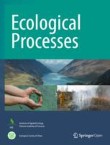Ver ítem
- xmlui.general.dspace_homeCentros Regionales y EEAsCentro Regional Patagonia SurEEA Santa CruzArtículos científicosxmlui.ArtifactBrowser.ItemViewer.trail
- Inicio
- Centros Regionales y EEAs
- Centro Regional Patagonia Sur
- EEA Santa Cruz
- Artículos científicos
- Ver ítem
Soil organic carbon stocks in native forest of Argentina: a useful surrogate for mitigation and conservation planning under climate variability
Resumen
Background The nationally determined contribution (NDC) presented by Argentina within the framework of the Paris Agreement is aligned with the decisions made in the context of the United Nations Framework Convention on Climate Change (UNFCCC) on the reduction of emissions derived from deforestation and forest degradation, as well as forest carbon conservation (REDD+). In addition, climate change constitutes one of the greatest threats to forest
[ver mas...]
Background The nationally determined contribution (NDC) presented by Argentina within the framework of the Paris Agreement is aligned with the decisions made in the context of the United Nations Framework Convention on Climate Change (UNFCCC) on the reduction of emissions derived from deforestation and forest degradation, as well as forest carbon conservation (REDD+). In addition, climate change constitutes one of the greatest threats to forest biodiversity and ecosystem services. However, the soil organic carbon (SOC) stocks of native forests have not been incorporated into the Forest Reference Emission Levels calculations and for conservation planning under climate variability due to a lack of information. The objectives of this study were: (i) to model SOC stocks to 30 cm of native forests at a national scale using climatic, topographic and vegetation as predictor variables, and (ii) to relate SOC stocks with spatial–temporal remotely sensed indices to determine biodiversity conservation concerns due to threats from high inter‑annual climate variability. Methods We used 1040 forest soil samples (0–30 cm) to generate spatially explicit estimates of SOC native forests in Argentina at a spatial resolution of approximately 200 m. We selected 52 potential predictive environmental covariates, which represent key factors for the spatial distribution of SOC. All covariate maps were uploaded to the Google
Earth Engine cloud‑based computing platform for subsequent modelling. To determine the biodiversity threats from high inter‑annual climate variability, we employed the spatial–temporal satellite‑derived indices based on Enhanced Vegetation Index (EVI) and land surface temperature (LST) images from Landsat imagery. Results SOC model (0–30 cm depth) prediction accounted for 69% of the variation of this soil property
across the whole native forest coverage in Argentina. Total mean SOC stock reached 2.81 Pg C (2.71–2.84 Pg C with a probability of 90%) for a total area of 460,790 km2, where Chaco forests represented 58.4% of total SOC stored, followed by Andean Patagonian forests (16.7%) and Espinal forests (10.0%). SOC stock model was fitted as a function of regional climate, which greatly influenced forest ecosystems, including precipitation (annual mean precipitation and precipitation of warmest quarter) and temperature (day land surface temperature, seasonality, maximum temperature of warmest month, month of maximum temperature, night land surface temperature, and monthly minimum temperature). Biodiversity was influenced by the SOC levels and the forest regions. Conclusions In the framework of the Kyoto Protocol and REDD+, information derived in the present work from the estimate of SOC in native forests can be incorporated into the annual National Inventory Report of Argentina
to assist forest management proposals. It also gives insight into how native forests can be more resilient to reduce the impact of biodiversity loss.
[Cerrar]

Autor
Peri, Pablo Luis;
Gaitan, Juan Jose;
Mastrangelo, Matias Enrique;
Nosetto, Marcelo Daniel;
Villagra, Pablo Eugenio;
Balducci, Ezequiel Diego;
Pinazo, Martin Alcides;
Eclesia, Roxana Paola;
Von Wallis, Alejandra;
Villarino, Sebastián;
Alaggia, Francisco Guillermo;
Gonzalez-Polo, Marina;
Manrique, Silvana M.;
Meglioli, Pablo A.;
Rodríguez‑Souilla, Julián;
Mónaco, Martín H.;
Chaves, Jimena Elizabeth;
Medina, Ariel;
Gasparri, Ignacio;
Alvarez Arnesi, Eugenio;
Barral, María Paula;
Von Müller, Axel;
Pahr, Norberto Manuel;
Uribe Echevarria, Josefina;
Fernandez, Pedro Sebastian;
Morsucci Labiano, Marina;
Lopez, Dardo Ruben;
Cellini, Juan Manuel;
Alvarez, Leandro M.;
Barberis, Ignacio Martín;
Colomb, Hernán Pablo;
La Manna, Ludmila;
Barbaro, Sebastian Ernesto;
Blundo, Cecilia;
Sirimarco, Marina Ximena;
Cavallero, Laura;
Zalazar, Gualberto;
Martínez Pastur, Guillermo José;
Fuente
Ecological Processes 13 : 1 (2024)
Fecha
2024-01-05
Editorial
Springer Nature
ISSN
2192-1709
Formato
pdf
Tipo de documento
artículo
Palabras Claves
Derechos de acceso
Abierto
 Excepto donde se diga explicitamente, este item se publica bajo la siguiente descripción: Creative Commons Attribution-NonCommercial-ShareAlike 2.5 Unported (CC BY-NC-SA 2.5)
Excepto donde se diga explicitamente, este item se publica bajo la siguiente descripción: Creative Commons Attribution-NonCommercial-ShareAlike 2.5 Unported (CC BY-NC-SA 2.5)


